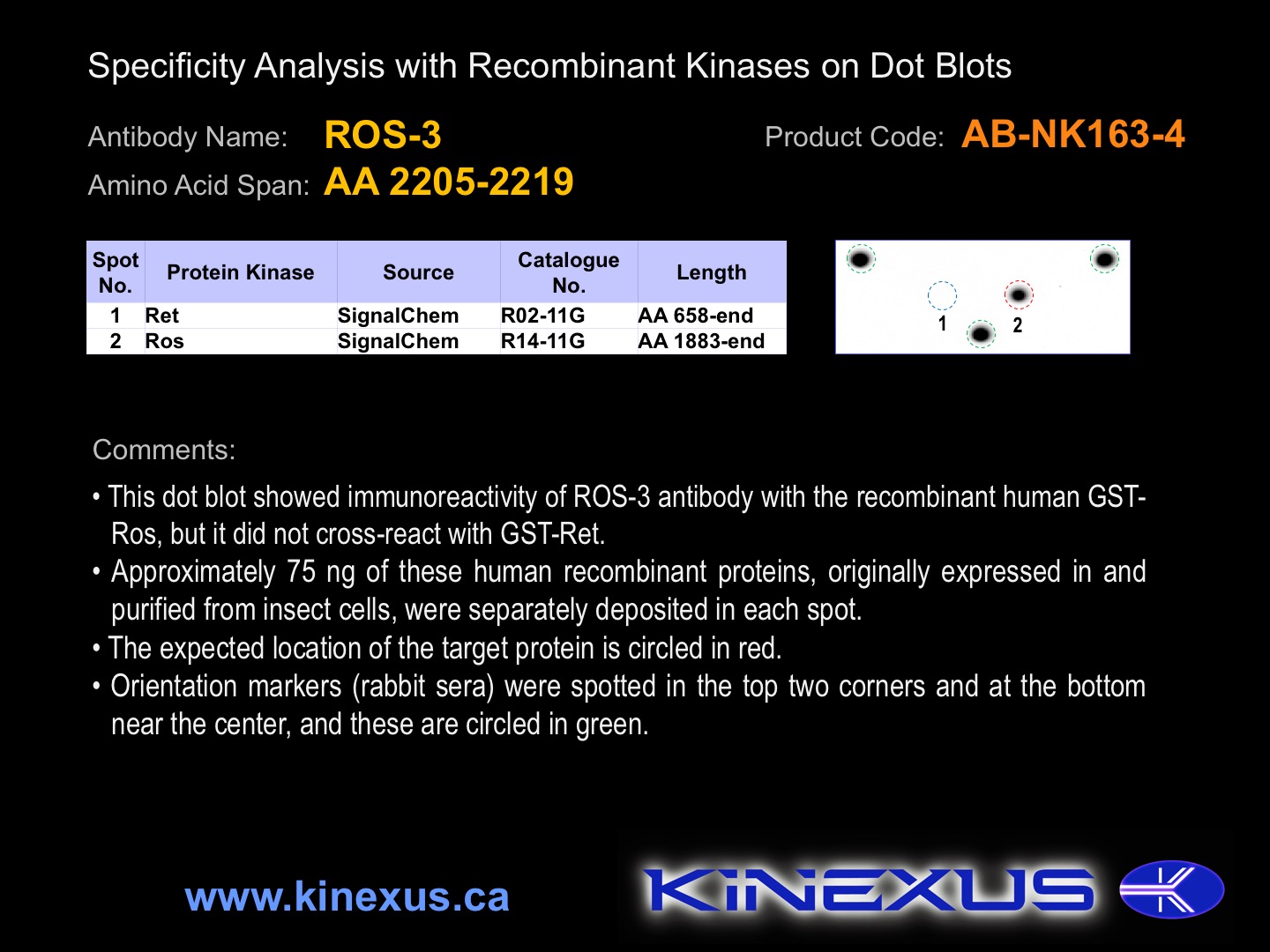Product Name: Ros-3
Product Number: AB-NK163-4
| Size: | 25 µg | Price: | 89.00 | |
| $US |
Target Full Name: Orosomucoid 1 receptor-tyrosine kinase; Proto-oncogene tyrosine-protein kinase ROS1
Target Alias: c-Ros oncogene 1 , receptor tyrosine kinase; c-Ros-1; KROS; MCF3; Proto-oncogene tyrosine-protein kinase ROS; ROS1; V-ros UR2 sarcoma virus oncogene homolog 1 (avian); V-ros UR2 sarcoma virus oncogene homologue 1 (avian); MGC163394; ENSG00000169071
Product Type Specific: Protein kinase pan-specific antibody
Antibody Code: NK163-4
Antibody Target Type: Pan-specific
Protein UniProt: P08922
Protein SigNET: P08922
Antibody Type: Polyclonal
Antibody Host Species: Rabbit
Target Alias: c-Ros oncogene 1 , receptor tyrosine kinase; c-Ros-1; KROS; MCF3; Proto-oncogene tyrosine-protein kinase ROS; ROS1; V-ros UR2 sarcoma virus oncogene homolog 1 (avian); V-ros UR2 sarcoma virus oncogene homologue 1 (avian); MGC163394; ENSG00000169071
Product Type Specific: Protein kinase pan-specific antibody
Antibody Code: NK163-4
Antibody Target Type: Pan-specific
Protein UniProt: P08922
Protein SigNET: P08922
Antibody Type: Polyclonal
Antibody Host Species: Rabbit
Antibody Immunogen Source: Human Ros sequence peptide Cat. No.: PE-01AVI90
Antibody Immunogen Sequence: CRPTFHRIQDQLQLFR
Antibody Immunogen Description: Corresponds to amino acid residues R2205 to R2219; Kinase last alpha-chain
Antibody Immunogen Sequence: CRPTFHRIQDQLQLFR
Antibody Immunogen Description: Corresponds to amino acid residues R2205 to R2219; Kinase last alpha-chain
Production Method: The immunizing peptide was produced by solid phase synthesis on a multipep peptide synthesizer and purified by reverse-phase hplc chromatography. Purity was assessed by analytical hplc and the amino acid sequence confirmed by mass spectrometry analysis. This peptide was coupled to KLH prior to immunization into rabbits. New Zealand White rabbits were subcutaneously injected with KLH-coupled immunizing peptide every 4 weeks for 4 months. The sera from these animals was applied onto an agarose column to which the immunogen peptide was thio-linked. Antibody was eluted from the column with 0.1 M glycine, pH 2.5. Subsequently, the antibody solution was neutralized to pH 7.0 with saturated Tris.
Antibody Modification: Unconjugated. Contact KInexus if you are interest in having the antibody biotinylated or coupled with fluorescent dyes.
Antibody Concentration: 1 mg/ml
Antibody Modification: Unconjugated. Contact KInexus if you are interest in having the antibody biotinylated or coupled with fluorescent dyes.
Antibody Concentration: 1 mg/ml
Storage Buffer: Phosphate buffered saline pH 7.4, 0.05% Thimerasol
Storage Conditions: For long term storage, keep frozen at -40°C or lower. Stock solution can be kept at +4°C for more than 3 months. Avoid repeated freeze-thaw cycles.
Product Use: Western blotting | Antibody microarray
Antibody Dilution Recommended: 2 µg/ml for immunoblotting
Antibody Potency: Strong immunoreactivity with recombinant human Ros on protein dot blots.
Antibody Species Reactivity: Human; Mouse
Antibody Positive Control: The observed molecular mass of the processed target protein on SDS-PAGE gels is reported to be around 200-300 kDa.
Storage Conditions: For long term storage, keep frozen at -40°C or lower. Stock solution can be kept at +4°C for more than 3 months. Avoid repeated freeze-thaw cycles.
Product Use: Western blotting | Antibody microarray
Antibody Dilution Recommended: 2 µg/ml for immunoblotting
Antibody Potency: Strong immunoreactivity with recombinant human Ros on protein dot blots.
Antibody Species Reactivity: Human; Mouse
Antibody Positive Control: The observed molecular mass of the processed target protein on SDS-PAGE gels is reported to be around 200-300 kDa.
Antibody Specificity: High
Antibody Cross Reactivity: No immunoreactivity on protein dot blots with recombinant human Ret.
Related Product 1: Ros-3 blocking peptide
Related Product 2: Ros-1 pan-specific antibody (Cat. No.: AB-NK163-2)
Related Product 3: Ros-2 pan-specific antibody (Cat. No.: AB-NK163-3)
Related Product 4: Ros-pY2114+pY2115 phosphosite-specific antibody (Cat. No.: AB-PK803)
Antibody Cross Reactivity: No immunoreactivity on protein dot blots with recombinant human Ret.
Related Product 1: Ros-3 blocking peptide
Related Product 2: Ros-1 pan-specific antibody (Cat. No.: AB-NK163-2)
Related Product 3: Ros-2 pan-specific antibody (Cat. No.: AB-NK163-3)
Related Product 4: Ros-pY2114+pY2115 phosphosite-specific antibody (Cat. No.: AB-PK803)
Scientific Background: Ros (Ros1) is a protein-tyrosine kinase of the TK group and Sev family. It is an orphaned receptor kinase. It has been suggested to activate several downstream signalling pathways in cell differentiation, proliferation, growth and survival including the PI3 kinase-mTOR signalling pathway. Ros1 is highly expressed in several human cancers. A K1980M mutation can lead to impaired phosphotransferase activity, while the mutations Y2274F or Y2334F can lead to loss of phosphorylation and impaired complex formation with PTPN11. It appears to be an oncoprotein (OP). Cancer-related mutations in human tumours point to a gain of function of the protein kinase. The active form of the protein kinase normally acts to promote tumour cell proliferation. Ros is linked to Glioblastoma Multiforme, in which this protein-tyrosine kinase can be constitutively active. This activity can arise either from ROS fusion with the FIG protein or a deletion (q21q21) leading to GOPC-Ros1. Non-small cell lung carcinoma can arise from a SLC34A2-ROS1 fusion expressing the chimeric CD74-ROS1 protein. In non-small cell lung cancer a gain of function has been observed with Mlk1 (MAP3K9), activating ERK downstream. Interestingly, its pattern of diverse mutations in human tumours is actually more characteristic of a tumour suppressor protein.
© Kinexus Bioinformatics Corporation 2017


